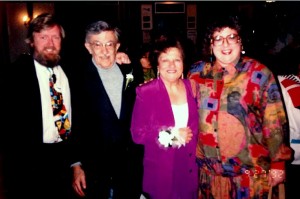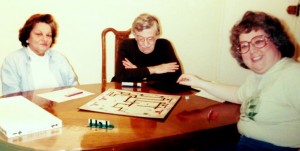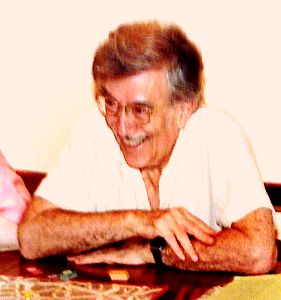“Games mean many things to many people; to me, they are an art form of great potential beauty.”—Sid Sackson
The clouds never lifted all day, nor did the oppressive humidity that soaked his all-white lawn bowling togs. But John’s dark mood had lifted for the few hours he was rolling the wooden balls toward the jack.
Among the staid regulars who filled the Central Park lawn bowling rink that Sunday, John stood out for his ebullient glee at a well-placed shot. He was having the time of his life!
I had to dodge a street full of marching environmentalists for a chance to bowl by his side last weekend. Since his club wraps up the season over Columbus Day weekend, we had very opportunities to share a game before he left the country for good. His goal is to be in Ireland by the time the next bowling season begins in April.
Our match seesawed between us over an abbreviated game of 10 ends, and we were knotted up at the end of regulation. I’m an old hand at bocce, where the mechanics are similar, so I was able to keep up. But my skills couldn’t get my last ball to move the ½” I needed to score in the extra End. John bathed in the well-earned victory. As well as bathing in the well-earned sweat….
Afterward, John treated me to a meal at one of the innumerable faux diners that line the edges of Manhattan Island. He doesn’t willingly talk about games anymore, but we did chat about Robin and about their old friend Sid Sackson, a predecessor at Games magazine.

It seems that whenever I talk to John about his collection, the conversation invariably turns to Sid’s monumental 18,000 game collection. John & Robin knew Sid well, and were occasional dinner and game companions with him and his wife, Bernice.
By all accounts, Sid was a remarkable man. Noted writer Martin Gardner once called him “the country’s leading game inventor.” That’s a word we don’t hear today, but long before there were game “designers” there were inventors, men who changed the course of tabletop gaming. And Sid Sackson was the preeminent Inventor.
While Sid is credited with creating over 500 games, only 50 or so were ever published commercially. There are 124 games accredited to Sid in the Board Game Geek database; most of them are prototypes.
Sid was one of the few designers of his day (he was born in 1920) who actually produced games meant to appeal to adults. He knew there was a world of fun out there beyond the old ‘roll-and-move.’
“It’s only important that the game [is] interesting.”—Sid Sackson
Sid came of age in the Depression and his family moved frequently, making it difficult for him to have friends. So he stayed indoors most of the time, playing his collection of games. He played them so frequently, he grew bored and tinkered with them. Taking pieces from different games he created new games, or changed the rules and made improvements.
For example, by his own words, “I sort of changed Uncle Wiggily so that there were four rabbits instead of just one. And I had the rabbits fight each other. I ended up with a completely different game.”
Another game he re-jiggered was Lotto, a forerunner of Bingo. Sid reworked it into what he called Lotto War, where empires battled across a card full of numbered squares..
He took his sharp mind to City College of New York where he graduated magna cum laude in civil engineering. He quickly got work designing weapons systems for warships built in the Brooklyn Navy Yard. And he later played a part in engineering the iconic World Trade Center, and the Verrazano-Narrows Bridge, at the time of construction the world’s longest span.

He married Bernice in 1941; they would be together for the last 61 years of Sid’s life. Sid & Bernice entertained themselves at first with jigsaw puzzles, but Sid’s busy mind soon grew bored again. They knew a couple who enjoyed playing games, and the four spent many nights gaming together. Over the decades, the Sacksons entertained frequently in their home. That is, when they weren’t out ballroom dancing, another one of Sid’s passions.
Through the years he continued tinkering with classic games, even publishing a few variations of age-old card games. He developed Poke, adding a trick-taking mechanic to Poker, and it was published in Esquire in 1946. Five years later his two-handed variation on Bridge, called Slam, was published in a nationally syndicated column.
“If I had to pick just one game to play for the rest of my life, it would be duplicate bridge. But I would really hate to be in that position.” – Sid Sackson
His first commercially published game was High Spirits. In 1962, Milton Bradley released it, but corrupted Sid’s adult game into a bland children’s game, crassly named after a now-forgotten TV cartoon.
In 1970, when he was unable to take time off from work to present his games in a week-long exhibition, Sid quit his job. “By then,” he said, “ I was making more money with games than as an engineer.”
He was prepared. All of his life he kept dairies, meticulously indexed, of ideas, session reports, and contacts. In fact, throughout his gaming days, he always had a note pad and pen handy. He wasn’t just an inventor, but a student, who researched and analyzed games.
“(A good game) should be easy to learn yet have infinite strategic possibilities, give you the chance to make choices, create interaction among players and take a maximum of one and a half hours to play.” — Sid Sackson
It’s said that musicians can look at a score and hear the melody in their heads. Sid claimed he could do the same thing with games. Just by looking at the rule book and inspecting a game’s components, he could tell before how it would play and whether it would be fun. He never especially cared if he won or lost—though he always played to win.
Sid didn’t lack for a variety of gamers to try out his creations. He had his own playtesting group, The New York Game Associates, decades before Meetup.com ever saw the light of a monitor. By the early 1990s, John & Robin were a regular part of Sids gaming circle.

As a game inventor, Sid was so far ahead of his time that he and the German game industry enjoyed a mutually satisfying business relationship long before America discovered what was then called ‘German Games.’
In 1981, Sackson won both the Spiel des Jahres and the Essen Feather for his abstract classic, Focus. (Though Acquire was up for the inaugural Spiel des Jahres Award in 1979, it only garnered a ‘recommendation.’)
It was a mutual appreciation, as Sid had many German games in his collection (a habit that John picked up when purchasing games for his own collection). While American game companies behaved as if their products came from nameless drones, European publishers proudly displayed the name of the game’s designer. In recent years, Gryphon Games has made up for such oversights by putting many of Sid’s games back into print.
“Germans consider it the parents’ duty to play games with their kids, but they avoid all war games.”—Sid Sackson
I only knew Sid through a handful of well-worn books in my library: Beyond Tic Tac Toe (a book Sid wanted you to write in!), Beyond Competition (cooperative games, in the 70s?), and his enduring classic, A Gamut of Games, which Gardner called “the most important book on games to appear in decades.”
This was the man who towered over the New York City gaming scene when John came to these shores to be with Robin. And intentionally or not, he shared some traits with the Master, including a similar style of writing reviews. John’s collection, which I’m still busy cataloging, is dwarfed by what Sid accumulated in 60 years of gaming.
Sid couldn’t bear to part with his collection during his lifetime. Oh, he talked about donating it, intact, to a museum and curating the collection himself, but he never made the arrangements by the time he died in 2002.
But unlike Sid, John is willing – no, desperate is more the word – to dispose of his collection as quickly and simply as possible. Still, he’s holding on to one last trait of Sid’s. John wants to keep his collection intact. It’s his only wish, other than to wish it out of his life for good.
Sid never got his wish. He never saw his games and prototypes donated to a museum or university. But neither did he live to see his historic collection broken into little pieces and sold off to collectors and speculators alike. What happened to that massive collection was an object lesson for John, one that will be covered in Part 3.
Oh,… that Lotto War game Sid worked on as a child…? He kept tinkering with the game through the years. In the early 1960s, when Minnesota Mining & Manufacturing (3M) saw a wide open field for board games oriented to adults, Sid approached the forward-thinking company with his new/old game, which he had renamed…. Vacation.
3M loved the game, but not the title; they suggested a new name and Sid agreed with them. 3M would go on to publish five other Sackson games, none as groundbreaking as Sid’s classic game of economics, Acquire.
 “Just as we never run out of new jokes, we’ll never run out of games.” – Sid Sackson
“Just as we never run out of new jokes, we’ll never run out of games.” – Sid Sackson
All photos are used by permission of John McCallion.
(I’m grateful to a number of online sources that I used for this and the next article. I apologize for not provided attributions for each tidbit I gleaned.The complete list of links will be provided at the end of Part 3.)



Show Comments